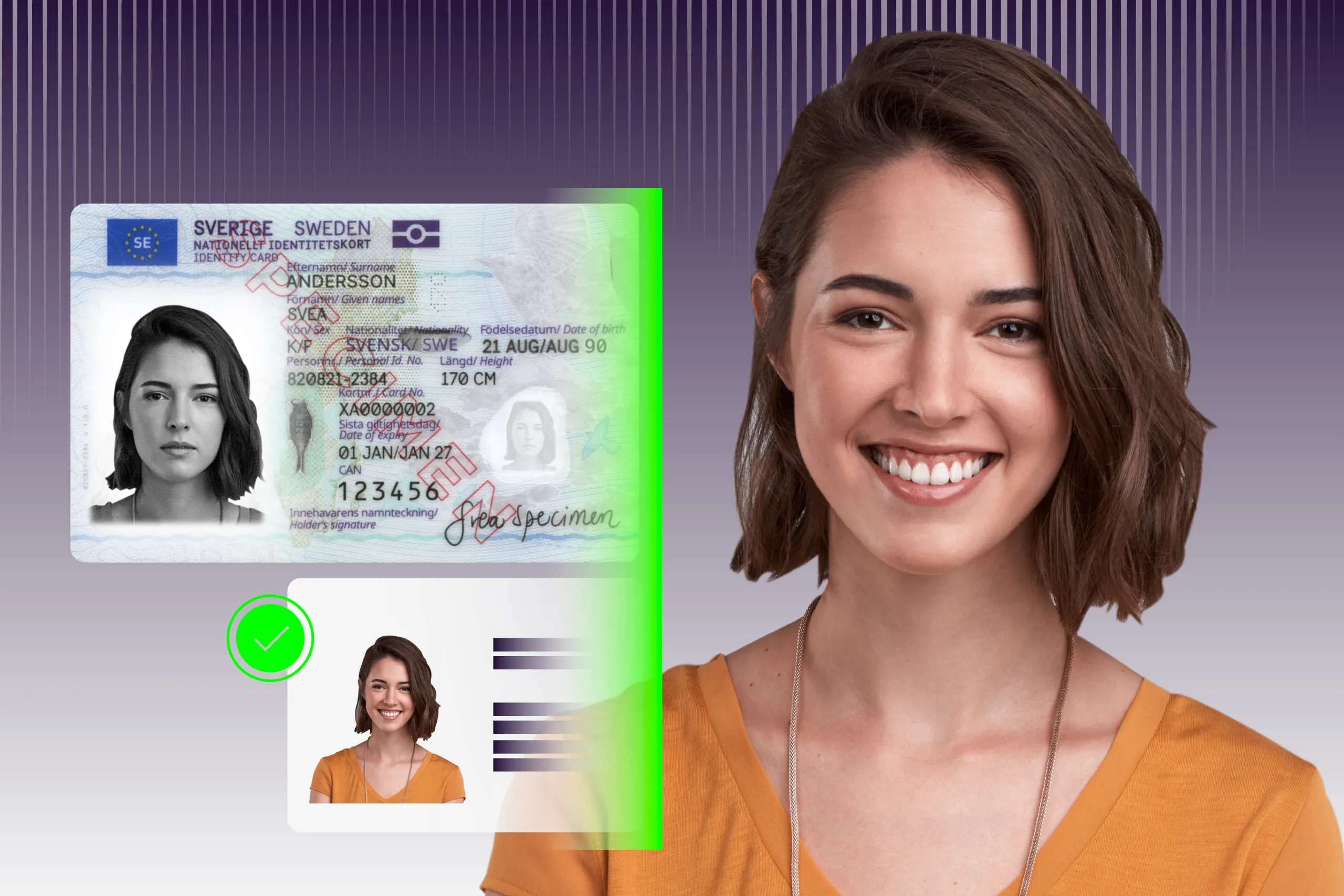At first glance, there seems to be little difference between verifying attendees at a global business forum and an international soccer championship. Both events attract tens of thousands of people who must confirm their identities when purchasing tickets and entering the venue. Both must manage long queues and ensure smooth identification and authentication. And finally, both are common targets for ticket scammers.
However, sports fans differ from regular attendees in several ways, making verification a unique challenge.
In this article, we'll explore the specifics of fan verification, plus offer effective solutions for sports clubs and major event organizers.
Why verify fans?
Fan verification shares many goals with general identity verification (IDV). First, organizers need to confirm that the person buying the ticket is a legitimate individual with the right to do so. Second, it’s essential to ensure that the ticket holder is the one attending the match.
This involves a standard flow that includes identification (ticket purchase) and authentication (venue entry).
However, regular event attendees may not require the same level of verification as sports fans.
For typical events, organizers can often rely on “less personalized” identifiers, like an email or phone number, rather than a government-issued ID or selfie. Fan verification, in contrast, usually involves more detailed identifiers, including a valid ID and face scan. This is partly because large events—like music festivals, religious gatherings, or expos—and sports events attract different types of audiences and have different environments.
Major sports leagues and clubs want to know who is attending their games for marketing, operational, and security reasons. They don’t just identify match-goers but also gather information on them, including new and returning fans, season-long attendees, and fans with a decades-long history. Each of these groups has different levels of interaction, which is reflected in the IDV process.
Subscribe to receive a bi-weekly blog digest from Regula
When to verify fans
IDV solutions support three main tasks at sports events:
Verify that the ticket purchaser is the same person attending the match.
Ensure that the person is authorized to attend the event via a ticket or season pass.
Provide quick, seamless entry to the stadium for fans, VIPs, athletes, and staff.
These tasks can be addressed in various ways. Here, we focus on two widely used methods: generating Fan IDs, and biometric verification using facial recognition.
Let’s break down the IDV process into two parts to see how the sports fan journey unfolds, from the initial idea of attending a match to arriving at the stadium.
When fans purchase tickets…
Sports event organizers handle two main groups of attendees: first-time spectators and regular fans. While newcomers need to go through both registration and identification, returning fans typically only need to complete authentication.
Usually, ticket purchases take place on an app or website, where users register by providing personal details, such as phone number, scanning their ID, and taking a selfie. This process generates a digital Fan ID—a unique QR code that serves as the attendee’s pass into the stadium.
During the FIFA World Cup 2022 in Qatar, Fan IDs also doubled as visas. Known as Hayya Cards, these multi-purpose IDs allowed fans access not only to stadiums but also to public transport, like the metro and buses. To get a Hayya Card, fans needed to buy tickets, then submit a selfie, passport scan, and other information through the official website.

After purchasing a game ticket, fans attending the FIFA World Cup 2022 could apply for a Hayya Card—a multi-purpose Fan ID—on the official website.
On the league's side, fans who complete the verification process are added to a “known visitors” database, streamlining authentication for upcoming and future games.
When fans enter the sports venue…
At this stage, a key IDV challenge is ensuring that the ticket purchaser matches the individual entering the stadium. Ticket sharing is common, and some people attempt to resell tickets multiple times for high-demand games.

Some ticketing sites, like HomeTown, offer ticket transfer as a legitimate option. To use this, the user must identify the person they wish to transfer the ticket to.
Additionally, certain visitors—including VIPs, staff, and players—require specific authentication procedures to meet both security and service goals.
Finally, organizers may need to identify banned fans who have been blacklisted due to misconduct, such as using pyrotechnics or committing hate crimes at previous events.
Now, let’s look at how sports event organizers address these IDV challenges.
How to verify fans
The fan verification method can vary depending on the specific sports event.
Fan ID verification
Once a person registers through the event app or web platform, they must complete identity document and biometric verification to confirm that their ID is genuine and matches their identity.
Since all purchased tickets link to a unique Fan ID, fans can simply present this ID on their phone to enter the venue. This is often a QR code that many IDV solutions can recognize and validate. Additionally, a selfie taken onsite is matched against the Fan ID photo for added verification.
This process can be fully automated with self-verification gates, or supported by event staff equipped with QR scanners and other tools for seamless fan verification.

The Scottish Rugby Ticketing App offers both single-game tickets and a digital Season Pass, which also serves as a Fan ID.
Fast lanes with facial recognition
At stadiums with cameras installed at gates, match-goers may not need to present Fan IDs—their face becomes their ticket.
As an individual approaches the gates, cameras capture their face, and biometric verification confirms if the face matches a registered user, granting or denying entry accordingly.
Fast lanes create a seamless experience for both fans and staff. Fans can walk through without scanning QR codes or showing ID, while the system automatically displays their profile on a device or gate screen. This process can be fully automated, using either CCTV or standard cameras connected to cloud-based or on-premises IDV software.
VIP access
Both Fan ID and fast-lane methods are often used for VIP guests entering lounges or VIP boxes, though without the need for gates. Staff members and athletes typically fall into the VIP category as well.
VIP Fan IDs can synchronize with CCTV cameras at entrances. As VIPs approach, the system automatically verifies their profile, eliminating the need for tickets or manual checks.
If a company doesn’t use Fan IDs, it can upload photos of VIP guests into its database. The camera then recognizes VIPs as they enter, displaying their profile—including preferences and feedback history—on staff devices.
While this may seem less secure, VIP access prioritizes service over security. The aim is quick identification without the need to show ID, ensuring VIP guests have a smooth, high-end experience.
Identifying banned fans
Finally, some individuals may be prohibited from attending the event. This restriction may appear on the ticketing platform, where a banned fan can’t purchase a ticket. However, with ticket-sharing and other fraud tactics in mind, it's critical to verify that the ticket holder is also the original buyer.
If a banned fan manages to obtain a ticket and reaches the stadium, facial recognition at the gate will flag them, preventing entry. If the system isn’t directly connected to the gate, staff will receive a notification on a device, allowing them to intervene and stop entry.

Face tickets enable sports event organizers to identify blacklisted fans and prevent them from entering the venue.
Detecting ticket fraud
Ahead of major sporting events, especially championships or key matches between well-known teams, scammers and ticket scalpers (resellers) are swarming. Scalpers often use bots to buy discounted early-bird tickets, either with fake or genuine identities. They then sell these tickets at higher prices as the event approaches, leading to situations where a single seat might be sold to multiple people.
Another challenge arises when legitimate ticket holders share their pass or season ticket with others.
To combat this, sports event organizers can employ fan ID verification combined with facial recognition. This approach helps identify fraud early in the ticketing process. For instance, bots are unlikely to complete selfie verification, and individuals attempting to enter with another person’s ticket can’t pass through gates equipped with facial recognition.
What to consider when verifying fans with Fan IDs and biometrics
Using digital Fan IDs and automated biometric checks can be a convenient way to manage fan verification at large sports events. Fans appreciate this alternative to paper tickets and long wait times. However, there are some potential pitfalls to consider when implementing such systems.
Here are the key factors to ensure success:
Seamless user experience during identification
The fan journey begins with registration and identification in the app or web platform where they purchase tickets. It’s essential to provide clear, step-by-step instructions for the selfie verification process.
Without detailed guidance, fans may submit photos taken in dim lighting or while wearing sunglasses or hats, leading to verification issues at the entrance. This requires the individual to retake their photo, causing delays for others.
Additionally, your IDV solution should reject inappropriate selfies that are difficult to match with the fan’s profile.

A selfie taken for verification must meet specific requirements to match the user’s ID photo, such as no accessories like hats or non-prescription glasses, and a neutral expression.
Backup solutions in place
Establish multiple fan verification options. Even if the facial recognition system fails, attendees can still be verified via QR codes, which staff can scan manually.
Backup methods are also helpful for fans who prefer not to use biometric verification. For these attendees, event organizers often provide traditional lanes with manual ID checks. Although these lanes may have longer wait times, they respect some people’s need for a non-biometric option.
Mixed types of entrance lanes
This consideration ties into the previous point. Beyond attendee preferences, it's often costly to equip all stadium entrances with facial recognition technology. Installing smart cameras at every gate requires substantial investment.
To balance security and operational costs, many clubs and leagues designate certain lanes for face or QR code verification, while others use traditional lanes with manual checks. This mixed approach accommodates different attendee groups and helps manage queues more effectively.
Reliable internet connection
While this may not always be top of mind, strong internet connectivity and bandwidth are critical components of any IDV system.
Digital verification methods, including Fan IDs and face tickets, require high-speed computing with access to large databases. Reliable internet bandwidth is essential for these systems. For stadiums with over 100,000 seats, it’s crucial to have stable Wi-Fi or mobile network connectivity for fan devices.
Fan profiles linked with incidents
Linking a fan’s digital ID to incidents at events—whether for access control, ticket purchases, or ticket transfers—provides transparency and valuable insights for different departments managing major sports events. This can also serve as a separate database, allowing companies to identify banned fans through ID or biometrics.
This helps address challenges around violence or ticket fraud by allowing event staff to trace and respond to specific incidents linked to individual attendees.
Privacy compliance
Any IDV solution must comply with local regulations governing biometric verification. For large events in Europe, organizers need to adhere to the General Data Protection Regulation (GDPR).
Under the GDPR, fans must consent to the use of their facial data for authentication. Furthermore, attendee data must be stored locally within Europe, with clear information provided on how and where data is stored, who can access it, and the purpose of collecting it. Fans should also have the option to opt out of biometric data collection at any time via the app or web platform.
Data security and tokenization
IDV providers should allow sports entities to choose whether client data is stored on-premises or in a private cloud.
With today’s advanced infrastructure and technology, there is a minimal risk of biometric data breaches. The encryption framework used is on par with banking security standards. Instead of storing actual photos, these systems store digital descriptors or tokenized versions of faces. Even in the event of a hack, the captured data would only be a series of encrypted numbers that can’t be decrypted back into the original image.
Wrapping up
Since the pandemic, people have grown accustomed to watching sports from home. Today, it’s the comfort of a couch and TV—not ticket scammers or banned fans—that presents the biggest challenge for sports event organizers.
To draw fans back to the stadiums and courts, companies must provide a seamless experience at every touchpoint, from accessible parking and well-stocked concession stands to efficient Fan ID generation and fast lanes equipped with facial recognition.
Most clubs already have traditional infrastructure in place; optimizing these systems can elevate the fan experience. A robust IDV solution is a critical component of the modern sports ecosystem, offering substantial value with only a modest additional investment.





